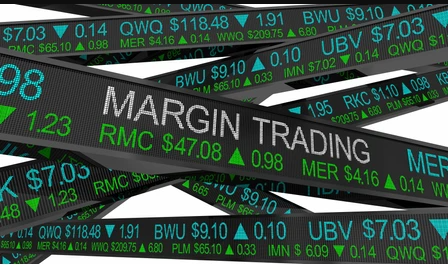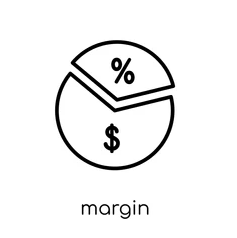What is Free Margin in Forex
Perhaps you've heard of the word "free margin" in forex trading before, or maybe it's a completely new term to you. Either way, it’s an important topic that you must understand to become a good forex trader.
In this guide, we are going to break down what free margin is in forex, how it can be calculated, how it relates to leverage, and much more.
So make sure to stick till the end!
What is margin?
First, let's discuss what margin means in forex trading.
When trading forex, you just need a small amount of capital to open and hold a new position.
This capital is called margin.
For example, if you want to buy $10,000 worth of USD/CHF, you don't have to put up the entire amount; instead, you can put up a part, such as $200.
Margin can be called a good faith deposit or security required to open and maintain a position.
It is an assurance that you can continue to keep the trade open until it is closed.
Margin is not a charge or a transaction cost. Rather, it is a fraction of your funds that forex broker blocks on your account to keep your trade open, and ensure that you can compensate for any future losses. The broker uses or locks up this portion of your funds for the duration of the specific trade.

When you close a trade, the margin is "freed" or "released" back into your account and is now available to open new trades.
The margin required by your forex broker will determine the maximum leverage you can use in your trading account. As a result, trading with leverage is also known as trading on margin.
Every broker has different margin requirements, which you should be aware of before selecting a broker and starting trading on margin.
Margin trading can have a variety of outcomes. It can positively or negatively impact your trading results, so it is a two-edged sword.
What does Free Margin mean?
Now that you know what margin trading is and how it works, it's time to move to margin types. The margin has two types; used and free margin.
The total margin from all open positions is added together to form the used margin.
The difference between equity and used margin is the free margin. To put it another way, free margin is the amount of money in a trading account used to open new positions.
You might be wondering, "What is the equity"?
Equity is the sum of the account balance and unrealized profit or loss from all open positions.
When we talk about account balance, we're referring to the total amount of money deposited in the trading account (this also contains the used margin for any open positions). If you have no open positions, your equity is equal to your trading account balance.
The formula for equity is:
Equity = account balance + floating profits (or losses)
Free margin is also referred to as usable margin because it is a margin you can use.
Before digging deeper into the free margin, you have to understand three key concepts; margin level, margin call and stop-out.
1. Margin level
The margin level is a percentage value calculated by dividing the equity by the used margin.
The margin level indicates how much of your funds are available for new trades.
The higher your margin level, the more free margin you have to trade with.
Assume you have a $10,000 account balance and want to open a trade that needs a $1,000 margin.
If the market shifts against you, resulting in a $9,000 unrealized loss, your equity will be $1,000 (i.e. $10,000 - $9,000). In this case, your equity equals your margin, implying that your margin level is 100 percent. This indicates you will no longer be able to add new positions to your account unless the market goes in your favorable direction and your equity rises again, or you deposit more money into your account.
2. Margin call
When your broker warns you that your margin level has dropped below the specified minimum level, this is referred to as a margin call.
A margin call occurs when your free margin is well belo zero and all that remains in your trading account is your used, or required, margin.

3. Stop out level
A stop-out level in forex trading occurs when your margin level falls below a critical level. At this point, one or more of your open positions are automatically liquidated by your broker.
This liquidation occurs when the trading account's open positions can no longer be supported due to the lack of funds.
More precisely, the stop-out level is reached when the equity falls below a certain percentage of the used margin.
If this level hits, your broker will automatically begin closing out your trades, starting with the least profitable, before your margin level come back to above the stop-out level.
A keynote to add here is your broker will close your positions in descending order, beginning with the largest position. Closing a position releases the used margin, which raises the margin level and may carry it back over the stop-out level. If it does not, or if the market continues to move against you, the broker will close positions.
Ok, coming back to free margin!
Here's how you can calculate free margin:
Calculating free margin
Free margin is calculated as:
Free margin = equity - used margin
If you have open positions that are already profitable, your equity will rise, which means you will have increased free margin.
If you have losing open positions, your equity will decrease, which means you will have less free margin.
Free margin examples
- Let's say you don't have any open positions, and your account balance is $1000. So, what will be your free margin?
Let's calculate using the equations mentioned above.
Equity = account balance + floating profits/losses
$1,000 = $1,000 + $0
You have no floating gains or losses because you don't have any available positions.
If you don't have any open positions, the free margin equals the equity.
Free margin = equity - used margin
$1,000 = $1,000 - $0
The above equation signifies that your free margin will be the same as your account balance and equity.
- Now let’s say you want to open a position costing $10,000 and have a trading account with a balance of $1,000 and a margin of 5% (leverage 1:20). This is what your overall trading position will look like:
- Account balance = $1,000
- Margin = $500 (5% of $10,000)
- Free margin = $500 (equity - used margin)
- Equity = $1,000
If the value of your position increases, giving a profit of $50, now the trading scenario will look like:
- Account balance = $1,000
- Margin = $500
- Free margin = $550
- Equity = $1,050
The used margin and account balance remain unchanged, but the free margin and equity both rise to illustrate the profit of the open position. It is worth noting that if the value of your position had decreased rather than increased by $50, the free margin and equity would have decreased by the same amount.
Pros of margin in forex
The benefit of margin trading is that you will make a large percentage of your account balance in profits. For example, suppose you have a $1000 account balance and are trading on margin.
You start a $1000 trade that yields 100 pips, with each pip worth 10 cents in a $1000 trade. Your trade resulted in a $10 profit or a 1% gain. If you used the same $1000 to make a 50:1 margin trade with a trade value of $50,000, 100 pips would give you $500, or a 50% profit.
Cons of margin in forex
Risk is one of the drawbacks of using margin. Let us make the opposite assumption that we did while addressing the pros. You're already making use of a $1000 account balance.
You open a trade for $1000 and lose 100 pips. Your loss is just $10, or 1%. This isn't too bad; you'd still have plenty of money to try again. If you make a 50:1 margin trade for $50,000, a loss of 100 pips equals $500, or 50% of your equity. If you lose again on trade like that, your account will be empty.
Bottom line
Margin trading can be a lucrative forex strategy, but you must understand all of the risks involved. If you want to use a free forex margin, you must ensure that you understand how your account works. Be sure to carefully read the margin requirements of your chosen broker.
Click on the button below to Download our "What is Free Margin in Forex" Guide in PDF


